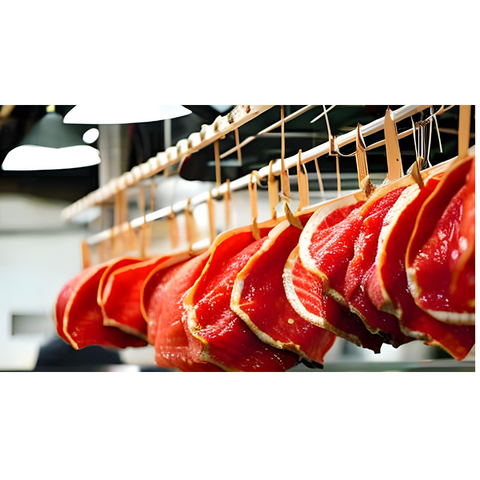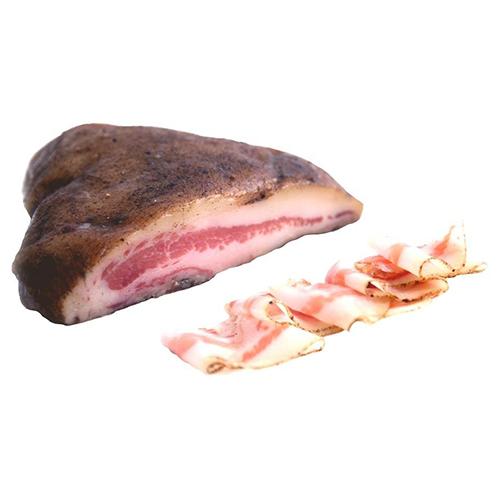In the tapestry of Italian culinary heritage, few ingredients stand out as boldly and distinctly as guanciale.
Guanciale is a cured meat that has been made in Italy for centuries. It is a testament to the Italian people's love of food and their time-honored craftsmanship.
A savory masterpiece woven into the hearts of food lovers worldwide, this Italian cured meat is an art form disguised as food.
Let’s dive into everything you need to know about guanciale–from its history and culture to its use in modern-day culinary arts.
Unveiling the Delicacy: What Is Guanciale?
The word guanciale is derived from the Italian word ‘guancia’, meaning cheek. It is a type of cured meat that fits its roots in the traditions of central and southern Italy. Unlike its more well-known counterparts, it has a unique depth of flavor and texture that makes it so special as an ingredient in Italian dishes.
The main ingredient in guanciale is pork jowl or cheek. This unassuming cut of meat is often overshadowed by other, more appetizing parts but acts as the star of the show when it comes to guanciale. Pork cheek contains marbling that gives an equal distribution of fat, which offers the equilibrium between bite and tenderness.
Preparing Guanciale
The preparation process is also highly traditional. Most people learn how to make guanciale from their elders, who learned it from their own elders, and so on.
The first step is to select the pork jowls. This is done with much consideration and care to find the dish's best pieces. These are then meticulously trimmed and kept aside for preparation. They are then coated with a generous mixture of salt, pepper, and aromatic herbs. Each country region also adds its unique touch to the seasoning; some have it rubbed with salt and others with ground black pepper.
Once they’ve been seasoned, the pork jowls are left for curing. This can take anywhere between weeks to months, depending on how intense the flavor is meant to be. The seasonings draw out the moisture over this time, dehydrating the meat and making the taste more concentrated.
But that’s not all! After the curing, the pork jowls are hung up and left to air dry. This is to add to the process of removing moisture but also results in complex enzymatic reactions within the meat, which further add to the flavor.
The whole process intensifies the flavor tenfold, resulting in a symphony of flavor–a mix of saltiness, umami, and sweetness that makes guanciale such a beloved part of Italian cuisine.

Guanciale vs. Other Cured Meats
The golden trio of cured meats - guanciale, pancetta, and bacon - has been widely known for the way they add to the culinary arts. Each of these uses pork but brings different characteristics to the table. So what’s the difference between the other cured meats and guanciale?
Guanciale
It stands apart from other options because of its intense depth of flavor and unique texture. It’s a rich and well-marbled option with a generous fat content. When cooked, the fat infuses the dishes with richness and a signature umami quality.
This delicacy has an intricate and bold taste, mostly savory and nutty.
Pancetta
Pancetta is a close cousin of guanciale, though it boasts its own distinct character. It’s very frequently compared to bacon but is different in terms of preparation.
The meat used for pancetta comes from the belly of the pig and is prepared by rolling it up and seasoning it with spices and herbs. Pancetta has a milder and sweeter taste than guanciale and a leaner texture due to a lower fat content. Both can be used as an ingredient in traditional spaghetti alla carbonara.
Bacon
Bacon is a smoky, delicious treat that is enjoyed by people all over the world. Its distinctive flavor sets it apart from other cured meats. Like Pancetta, it’s also made from pork belly, but the preparation process also includes smoking.
The texture of bacon can vary, but it is usually known for being crispy when fried or baked. It has a mix of saltiness and sweetness, with a smokier taste than guanciale.

Using Guanciale in Culinary Arts
The culinary world is a canvas, and cured meats can be one of their many paints. The robust taste of this classic Italian meat shines brightest in dishes where it can add some depth.
Italian cuisine is known for its allure because of how it transforms simple ingredients into masterpieces.
It has a rich and savory profile, making it into plenty of Italy’s most iconic Italian pasta dishes.
Pasta alla Gricia
Pasta alla Gricia comes from the heart of Lazio and celebrates the essentials: pasta, Pecorino Romano cheese, black pepper, and of course, guanciale. The dish is simple but has a rustic charm because of how flavorful it is.
Amatriciana
Amatrice is a town known for its rich culinary heritage, and Pasta all’Amatriciana is one of these. A tomato-based delight combines pasta, vegetables, cheese, and guanciale. Like Pasta alla Gricia, it is a simple but flavorful dish, so it’s no wonder it’s loved by so many around the world.
Carbonara
Pasta alla Carbonara is famed for its creamy texture and rich flavors, but it really comes alive when you add guanciale to the mix.
At its core, carbonara is a study of contrasts. The egg and cheese sauce is luxuriously creamy, and the guanciale is salty and savory, with pasta keeping the two together. With each ingredient adding to the flavor, it’s no wonder the dish is so famous worldwide.
Nutritional Value & Health Considerations
As scrumptious as guanciale is, we also have to consider the nutritional composition. Guanciale definitely falls on the more indulgent side of foods, emphasising the flavor-rich fats that contribute to the taste.
Let’s consider each nutritional aspect.
Fat Content
The primary appeal of guanciale lies in its fat content, which gives it its texture and taste. On average, guanciale has around 60-65% fat in the form of marbled fat within the pork jowl. While the high-fat content is a hallmark of the luxury of guanciale, it’s definitely on the higher side.
Depending on your nutritional requirements and dietary conditions, you may want to limit the amount of guanciale you eat. As delicious as it is, too much fat may not be the best idea.
Calories
Due to the high-fat content, it makes sense that guanciale is energy-dense. As little as 50 grams of guanciale can contain up to 200 calories, which is quite a lot! The high-calorie concentration means eating too much of this delicacy is not a good idea.
Despite the appeal, guanciale is best in moderation.
Balancing Flavor & Wellness
For a culinary delight like this one, the richness, fat content, and high-calorie concentration raise a few questions about health. In excess, this cured meat isn’t the best for your body. But there are ways to create a balance for yourself.
Moderation is Key
Guanciale is best in moderation. Indulging occasionally doesn’t just let the culinary experience stay luxurious but also doesn’t compromise your health in the process. For a dish as delicious as this one, you definitely don’t want to eat so much that you get sick of it, anyway!
Pair with Nutrient-Rich Foods
You can balance it by pairing guanciale with more nutrient-dense ingredients like vegetables and legumes. Dishes, where these items are the focus, will also get a brand new depth of flavor by adding a little bit of guanciale, making them so much more delicious.
Portion Control
Pay attention to your portion sizes! Guanciale is best used as a flavor enhancer than as a dominant ingredient, so a little can go a long way. You don’t need a lot of guanciale to make your dish taste good.
Consider Leaner Alternatives
If health concerns are a priority, explore leaner alternatives. Pancetta, bacon, and even prosciutto are some options for substitutes. Keep in mind, though, that these aren’t necessarily healthy in excess either - but probably healthier than guanciale.
Embrace Variety
Guanciale definitely adds some uniqueness to dishes, but remember that variety is the spice of life. Rotating ingredient choices keeps you healthy and gives you diversity in your food.

Cultural Significance & Beyond
Guanciale isn’t just a culinary delight; it’s a deep-rooted part of Italian cultural and traditional cuisine. The origins of guanciale stretch back centuries, and we can see the cultural effect in how every region of Italy has its own version.
The presence of guanciale in Italian cuisine is deeply rooted in necessity and resourcefulness. When fridges and freezers didn’t exist, it was a way to preserve pork when there was an abundant amount to go around. This way, every part of the animal was put to use without wasting anything.
The purpose was practicality, but it gave rise to the masterful culinary techniques that turned a humble ingredient into such a gourmet delight.
Regional Variations
Just as Italy’s landscapes vary as you go north to south, so do the culinary traditions. Even the preparation of guanciale takes on regional nuances.
For example, in Lazio, it’s typically seasoned with black pepper, thyme, and rosemary before being air-dried. Meanwhile, Umbria uses red pepper flakes, while Campiana leans towards spicier seasoning.
Each region's distinct preparation methods add layers of flavor that reflect the culinary trends of their respective areas. How it's sliced and combined with other ingredients reflects the identity of each locale.
Guanciale's Cultural Role
Beyond its flavor enhancer role, Guanciale is significant in preserving cultural heritage and culinary traditions. As generations pass, preparing dishes with guanciale becomes a way for newer generations to connect with their ancestry and honor the past while embracing the present.
Because guanciale dishes often involve family recipes handed down through generations, it keeps stories, flavors, and techniques alive.
The regional differences also allow for communities within the same country to celebrate what makes them different while sharing their core identity with the world.
In today's globalized world, guanciale has become a symbol of Italian culture. Dishes like pasta carbonara and pasta all'amatriciana, which use this amazing meat, have become popular all over the world, introducing people to the flavors of Italy. Sharing culture and cuisine is a way to forge connections that transcend borders.
Guanciale's history isn't confined to the pages of cookbooks; it's etched into the very fabric of Italian life. With each bite, you don’t just savor the delicacy; you taste the love and dedication of generations past. Guanciale is a reminder that food isn’t just sustenance; it’s the living embodiment of culture, the connection with one’s roots and flavor that adds vibrance and excitement to life.

